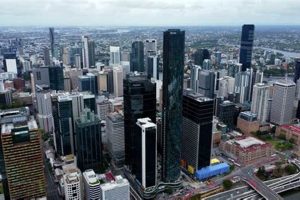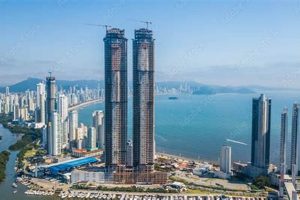Skyscraper drawing is a specialized field of architectural design that focuses on creating detailed representations of high-rise buildings. These drawings serve as blueprints for construction and provide a visual representation of a building’s design, structure, and aesthetics.
Skyscraper drawings are essential for the planning, design, and construction of tall buildings. They allow architects to visualize the building’s form, scale, and relationship to its surroundings. These drawings help ensure that the building is structurally sound, meets building codes, and aligns with the architect’s design intent.
The process of skyscraper drawing involves creating detailed plans, elevations, and sections that illustrate the building’s exterior and interior spaces. Architects use a combination of manual drafting techniques and computer-aided design (CAD) software to create these drawings.
Skyscraper drawings play a crucial role in the design and construction of some of the world’s most iconic structures. They are a testament to the skill and creativity of architects and engineers and serve as a valuable tool for visualizing and realizing the ambitious designs of modern architecture.
1. Precision
Precision is paramount in skyscraper drawing as it directly impacts the structural integrity and safety of the building. Highly precise drawings ensure that the building can withstand various loads and forces, including wind, earthquakes, and gravity, and that it meets all applicable building codes and regulations.
- Accurate Dimensions: Skyscraper drawings must accurately represent the dimensions of the building’s structural elements, such as columns, beams, and slabs. Any errors in dimensions can compromise the structural stability of the building.
- Detailed Connections: Skyscraper drawings must clearly illustrate how the building’s structural elements are connected to each other. These connections must be designed to transfer loads efficiently and prevent the building from collapsing.
- Material Specifications: Skyscraper drawings must specify the materials to be used in the building’s construction. The strength and properties of these materials must be carefully considered to ensure that the building can meet its design requirements.
- Construction Tolerances: Skyscraper drawings must account for construction tolerances, which are the allowable variations in the dimensions and positions of structural elements. These tolerances must be carefully managed to ensure that the building can be constructed safely and efficiently.
Overall, precision in skyscraper drawing is essential for ensuring the safety and integrity of high-rise buildings. By creating highly precise drawings, architects and engineers can ensure that these buildings can withstand the various forces that they will encounter throughout their lifetime.
2. Detail
In skyscraper drawing, detail is paramount. Skyscraper drawings must include intricate details of the building’s exterior and interior spaces to ensure that the building can be constructed safely and efficiently, and that it meets the architect’s design intent. Key aspects of detailing in skyscraper drawings include:
- Floor Plans: Floor plans show the layout of the building’s interior spaces, including the location of walls, doors, windows, and other features. Floor plans are essential for planning the building’s interior layout and ensuring that it meets the needs of the occupants.
- Elevations: Elevations show the exterior of the building from different sides. Elevations are essential for visualizing the building’s overall form and appearance, and for ensuring that it is aesthetically pleasing.
- Sections: Sections show the building’s interior structure, including the location of structural elements such as columns, beams, and slabs. Sections are essential for understanding the building’s structural system and ensuring that it is safe and stable.
Overall, detail is essential in skyscraper drawing. By including intricate details of the building’s exterior and interior spaces, architects can ensure that the building can be constructed safely and efficiently, and that it meets the architect’s design intent.
3. Scale
The scale of a skyscraper drawing is crucial, as it determines how accurately the building’s size and proportions are represented in relation to its surroundings. This is important for several reasons:
- Contextualization: Accurately representing the building’s scale allows architects and planners to visualize how it will fit into the surrounding urban environment. This ensures that the building does not overwhelm or overshadow its neighbors, and that it respects the overall scale and character of the area.
- Visual Impact: The scale of a skyscraper drawing also affects the visual impact of the building. A building that is drawn too large may appear imposing or out of place, while a building that is drawn too small may not have the desired impact. Architects carefully consider the scale of their drawings to ensure that the building will have the desired visual effect.
- Technical Considerations: The scale of a skyscraper drawing also has technical implications. The size of the building will determine the structural requirements, the amount of materials needed, and the construction methods that can be used. Accurate scale drawings are essential for ensuring that the building can be constructed safely and efficiently.
Overall, the scale of a skyscraper drawing is a critical factor that affects the building’s design, visual impact, and technical feasibility. By accurately representing the building’s scale in relation to its surroundings, architects can ensure that the building integrates seamlessly into the urban environment and meets the desired design objectives.
4. Communication
Skyscraper drawings serve as a critical means of communication in the design and construction of high-rise buildings. They enable architects to convey their design vision and intent to a diverse group of stakeholders, including engineers, contractors, and clients. Accurate and comprehensive skyscraper drawings facilitate effective collaboration and ensure that all parties have a shared understanding of the project.
- Precise Documentation: Skyscraper drawings provide pre
cise documentation of the building’s design, including its dimensions, materials, and structural systems. This detailed information allows engineers to analyze the building’s structural integrity and ensure its safety, while contractors can use the drawings to plan the construction process and estimate costs. - Visual Representation: Skyscraper drawings provide visual representations of the building’s design, allowing clients and stakeholders to visualize the project before construction begins. This helps to identify any potential issues or concerns early on and ensures that the final product aligns with the client’s expectations.
- Collaboration and Coordination: Skyscraper drawings facilitate collaboration and coordination among the design team, contractors, and clients. By sharing and reviewing the drawings, all parties can identify potential conflicts or overlaps in the design and construction process, enabling them to develop solutions and avoid costly mistakes.
- Legal and Regulatory Compliance: Skyscraper drawings are essential for obtaining building permits and ensuring compliance with building codes and regulations. They provide the necessary documentation to demonstrate that the building meets safety and structural requirements, protecting all parties involved in the project.
In summary, skyscraper drawings are a crucial tool for communication in the design and construction of high-rise buildings. They provide precise documentation, visual representation, facilitate collaboration, and ensure legal and regulatory compliance, ultimately contributing to the successful realization of complex and ambitious architectural projects.
5. Collaboration
In the context of skyscraper drawing, collaboration is essential for ensuring the successful design and construction of high-rise buildings. Skyscraper drawings are highly complex and technical documents that require the input and expertise of multiple professionals to ensure accuracy, safety, and aesthetic appeal. Here are some key facets of collaboration in skyscraper drawing and their implications:
- Expertise and Specialization: Skyscraper design and construction involve a wide range of specialized disciplines, including architecture, engineering, structural design, and construction management. Collaboration allows each professional to contribute their expertise to the project, ensuring that all aspects of the building are carefully considered and integrated.
- Problem-Solving and Innovation: Collaboration fosters a collective approach to problem-solving and innovation. By working together, architects, engineers, and other design professionals can brainstorm ideas, share knowledge, and develop creative solutions to complex design challenges.
- Design Integration: Skyscraper drawings must seamlessly integrate various design elements, from structural systems to aesthetic features. Collaboration ensures that all aspects of the design are coordinated and complementary, resulting in a cohesive and visually appealing building.
- Constructability and Efficiency: Collaboration between architects and engineers is crucial for ensuring that the design is constructible and efficient. Engineers can provide valuable input on the feasibility and cost-effectiveness of design elements, helping to optimize the building’s structural integrity and overall performance.
Ultimately, collaboration in skyscraper drawing is essential for producing high-quality, safe, and innovative high-rise buildings. By leveraging the expertise and perspectives of multiple professionals, architects can create iconic structures that push the boundaries of design and engineering.
6. Technology
The advent of computer-aided design (CAD) software has revolutionized the field of skyscraper drawing. CAD software provides architects and engineers with a powerful tool to create highly precise and detailed drawings, enhancing the design and construction process in numerous ways.
- Accuracy and Precision
CAD software allows for greater accuracy and precision in skyscraper drawings. Unlike manual drafting, which is prone to human error, CAD software ensures that lines, angles, and dimensions are exact, minimizing the risk of errors that could compromise the structural integrity of the building. - Efficiency and Productivity
CAD software streamlines the skyscraper drawing process, increasing efficiency and productivity. Architects can create drawings more quickly and easily, making changes and revisions on the fly without the need to redraw entire sections. This saves time and reduces the likelihood of errors. - Collaboration and Communication
CAD software facilitates collaboration and communication among architects, engineers, and other stakeholders involved in skyscraper design and construction. Drawings can be easily shared and reviewed, allowing for real-time feedback and coordination, reducing the risk of misinterpretations and costly mistakes. - Integration with Other Software
CAD software can be integrated with other software programs used in the design and construction process, such as structural analysis software and building information modeling (BIM) software. This integration allows for seamless data transfer and coordination, ensuring that all aspects of the skyscraper design are aligned and consistent.
In conclusion, the use of CAD software in skyscraper drawing has significantly enhanced the precision, efficiency, collaboration, and integration in the design and construction process. CAD software has become an indispensable tool for architects and engineers, enabling them to create iconic and innovative high-rise buildings that shape the skylines of cities around the world.
7. Creativity
Skyscraper drawings are not merely technical documents; they are also expressions of architectural creativity and ambition, pushing the boundaries of design and engineering to create iconic structures that shape the skylines of cities worldwide. This creativity manifests in various facets, each contributing to the unique character and impact of skyscraper drawings:
- Artistic Expression: Skyscraper drawings transcend their functional purpose and become works of art, reflecting the architect’s unique vision and style. Through the interplay of lines, forms, and proportions, architects create visually striking and emotionally resonant designs that captivate the imagination.
- Innovative Solutions: Skyscraper drawings often showcase innovative structural solutions and engineering feats. Architects explore novel ways to distribute loads, maximize space, and create sustainable and resilient buildings. These drawings unveil the ingenuity and problem-solving skills of architects, pushing the limits of what is considered structurally feasible.
- Cultural Significance: Skyscraper drawings embody the cultural and social aspirations of the time and place in which they are created. They reflect the economic prosperity, technological advancements, and architectural tr
ends of their era, becoming symbols of national pride and cultural identity. - Urban Planning: Skyscraper drawings play a crucial role in urban planning, influencing the development and character of cities. Architects consider the impact of their designs on the surrounding environment, ensuring that skyscrapers integrate seamlessly into the urban fabric and contribute positively to the cityscape.
In conclusion, skyscraper drawings are not just technical blueprints but also expressions of architectural creativity, ambition, and innovation. They represent the fusion of art, engineering, and urban planning, resulting in iconic structures that shape the skylines and enrich the lives of urban dwellers worldwide.
8. Innovation
Innovation is at the heart of skyscraper drawing, as architects and engineers push the boundaries of design and engineering to create ever taller and more ambitious structures. Skyscraper drawings often incorporate innovative design solutions to overcome the unique challenges of building tall, including structural stability, wind resistance, and efficient use of space.
- Structural Innovation: Skyscraper drawings often feature innovative structural systems to ensure the stability and integrity of the building. These systems may include diagrids, outrigger systems, and tuned mass dampers, all of which are designed to distribute loads efficiently and resist lateral forces such as wind and earthquakes.
- Wind Engineering: Skyscraper drawings incorporate advanced wind engineering techniques to mitigate the effects of wind on the building. Architects and engineers use wind tunnel testing and computational fluid dynamics (CFD) analysis to study the wind flow around the building and design aerodynamic shapes that minimize wind-induced vibrations and sway.
- Space Optimization: Skyscraper drawings explore innovative ways to maximize space and create efficient floor plans. This may involve the use of setbacks, sky gardens, and multi-level atriums to introduce natural light and create a sense of spaciousness within the building.
- Sustainable Design: Many skyscraper drawings incorporate sustainable design principles to reduce the environmental impact of the building. This may include the use of energy-efficient building materials, rainwater harvesting systems, and green roofs to promote sustainability and contribute to the overall well-being of the occupants.
The innovative design solutions incorporated in skyscraper drawings are a testament to the creativity and ingenuity of architects and engineers. These solutions push the limits of what is structurally feasible and allow for the creation of iconic and awe-inspiring high-rise structures that redefine the skylines of cities worldwide.
9. Sustainability
In the realm of skyscraper drawing, sustainability has emerged as a crucial consideration, driving architects and engineers to explore innovative design solutions that minimize the environmental impact of these towering structures. Sustainability in skyscraper drawing encompasses a wide range of factors, including energy efficiency, material selection, and overall building performance.
- Energy Efficiency: Skyscraper drawings increasingly incorporate energy-efficient measures to reduce the building’s energy consumption. This may involve the use of high-performance glazing, efficient lighting systems, and renewable energy sources such as solar panels and wind turbines.
- Material Selection: Architects and engineers are carefully considering the environmental impact of the materials used in skyscraper construction. Sustainable materials, such as recycled steel, low-VOC paints, and FSC-certified wood, are being incorporated into skyscraper drawings to minimize the building’s carbon footprint.
- Building Performance: Skyscraper drawings are analyzed using advanced simulation tools to evaluate the building’s overall performance in terms of energy consumption, daylighting, and indoor environmental quality. This analysis helps architects optimize the building’s design to reduce its environmental impact and enhance occupant comfort.
- Water Conservation: Water conservation is another important aspect of sustainability in skyscraper drawing. Architects are exploring innovative ways to reduce water usage, such as rainwater harvesting systems, low-flow fixtures, and drought-tolerant landscaping.
By integrating sustainability factors into skyscraper drawings, architects and engineers are creating high-rise buildings that are not only visually impressive but also environmentally responsible. These sustainable skyscrapers contribute to a greener and more sustainable built environment, reducing their carbon footprint and enhancing the well-being of occupants and the surrounding community.
FAQs on Skyscraper Drawing
Skyscraper drawing is a specialised field of architectural design that presents unique challenges and considerations. Here are some frequently asked questions and their answers to provide a deeper understanding of this fascinating subject:
Question 1: What is the primary purpose of a skyscraper drawing?
Answer: Skyscraper drawings serve as blueprints for the construction of high-rise buildings. They provide detailed visual representations of the building’s design, structure, and aesthetics, guiding engineers, contractors, and architects throughout the construction process.
Question 2: What are the essential elements of a skyscraper drawing?
Answer: Skyscraper drawings typically include floor plans, elevations, sections, and details. These elements collectively illustrate the building’s dimensions, layout, structural systems, and material specifications.
Question 3: What are the key considerations in creating precise skyscraper drawings?
Answer: Precision is paramount in skyscraper drawing to ensure structural integrity and safety. Architects and engineers must meticulously represent dimensions, connections, material properties, and construction tolerances to create drawings that accurately reflect the intended design.
Question 4: How does technology aid in skyscraper drawing?
Answer: Computer-aided design (CAD) software has revolutionized skyscraper drawing. CAD tools enhance precision, streamline the design process, facilitate collaboration, and enable integration with other software used in structural analysis and building information modeling.
Question 5: What role does sustainability play in contemporary skyscraper drawing?
Answer: Sustainability has become an integral aspect of skyscraper drawing. Architects consider energy efficiency, material selection, water conservation, and overall building performance to minimize environmental impact and promote occupant well-being.
Question 6: How do skyscraper drawings contribute to urban planning and development?
Answer: Skyscraper drawings play a crucial role in urban planning by influencing the scale, density, and character o
f cities. Architects consider the impact of their designs on the surrounding environment, ensuring that skyscrapers integrate harmoniously into the urban fabric and contribute positively to the cityscape.
Summary: Skyscraper drawing is a complex and dynamic field that requires precision, attention to detail, and a deep understanding of structural principles. By incorporating advanced technologies and sustainable practices, architects can create towering structures that not only meet functional and aesthetic requirements but also contribute to the overall well-being of cities and their inhabitants.
Transition to the next article section: The intricate world of skyscraper drawing continues to evolve, with architects and engineers constantly pushing the boundaries of design and innovation. As technology advances and sustainability concerns gain prominence, the future of skyscraper drawing promises to be even more remarkable.
Skyscraper Drawing Tips
Creating precise and informative skyscraper drawings requires a combination of technical expertise and creative vision. Here are some valuable tips to enhance your skyscraper drawing skills:
Tip 1: Master the Fundamentals
Develop a strong foundation in architectural drafting principles, including orthographic projection, dimensioning, and line conventions. This will ensure the accuracy and clarity of your drawings.
Tip 2: Embrace Technology
Utilize computer-aided design (CAD) software to streamline your drawing process. CAD tools offer precision, efficiency, and the ability to easily modify and share your designs.
Tip 3: Pay Attention to Detail
Skyscraper drawings require meticulous attention to detail. Carefully represent dimensions, connections, material specifications, and construction tolerances to ensure the structural integrity and safety of the building.
Tip 4: Collaborate Effectively
Collaborate with engineers, architects, and other professionals involved in the project. Open communication ensures that all aspects of the design are considered and integrated.
Tip 5: Consider Sustainability
Incorporate sustainable practices into your drawings. Consider energy efficiency, material selection, water conservation, and overall building performance to minimize environmental impact.
Tip 6: Study Precedents
Analyze existing skyscrapers and their drawings to gain insights into successful design solutions. Learn from the experiences of others to enhance your own designs.
Tip 7: Seek Feedback
Regularly seek feedback from experienced professionals or mentors. Constructive criticism can help you identify areas for improvement and refine your drawing skills.
Tip 8: Stay Updated
Keep up with the latest advancements in skyscraper design, construction techniques, and drawing technologies. Continuous learning ensures that your skills remain relevant and competitive.
These tips will empower you to create precise, detailed, and innovative skyscraper drawings that meet the highest standards of architectural design and engineering.
Skyscraper Drawing
Skyscraper drawing stands as a pivotal discipline in the realm of architecture, demanding precision, creativity, and a profound understanding of structural principles. Through the creation of detailed blueprints, architects and engineers bring towering visions to life, shaping the skylines of modern cities.
The intricate world of skyscraper drawing encompasses various facets, each contributing to the overall success of these architectural marvels. From meticulous attention to detail to the incorporation of sustainable practices, every aspect of skyscraper drawing plays a crucial role in ensuring structural integrity, functionality, and aesthetic appeal.
As we look towards the future of skyscraper drawing, it is evident that technology will continue to play a transformative role. Advanced design tools and simulation software will empower architects to explore innovative design solutions, push the boundaries of structural engineering, and create skyscrapers that are not only visually stunning but also environmentally responsible.
The pursuit of excellence in skyscraper drawing requires a commitment to continuous learning, collaboration, and a deep-seated passion for architectural design. By embracing these principles, architects and engineers can continue to create iconic structures that redefine the skylines of tomorrow and inspire generations to come.







